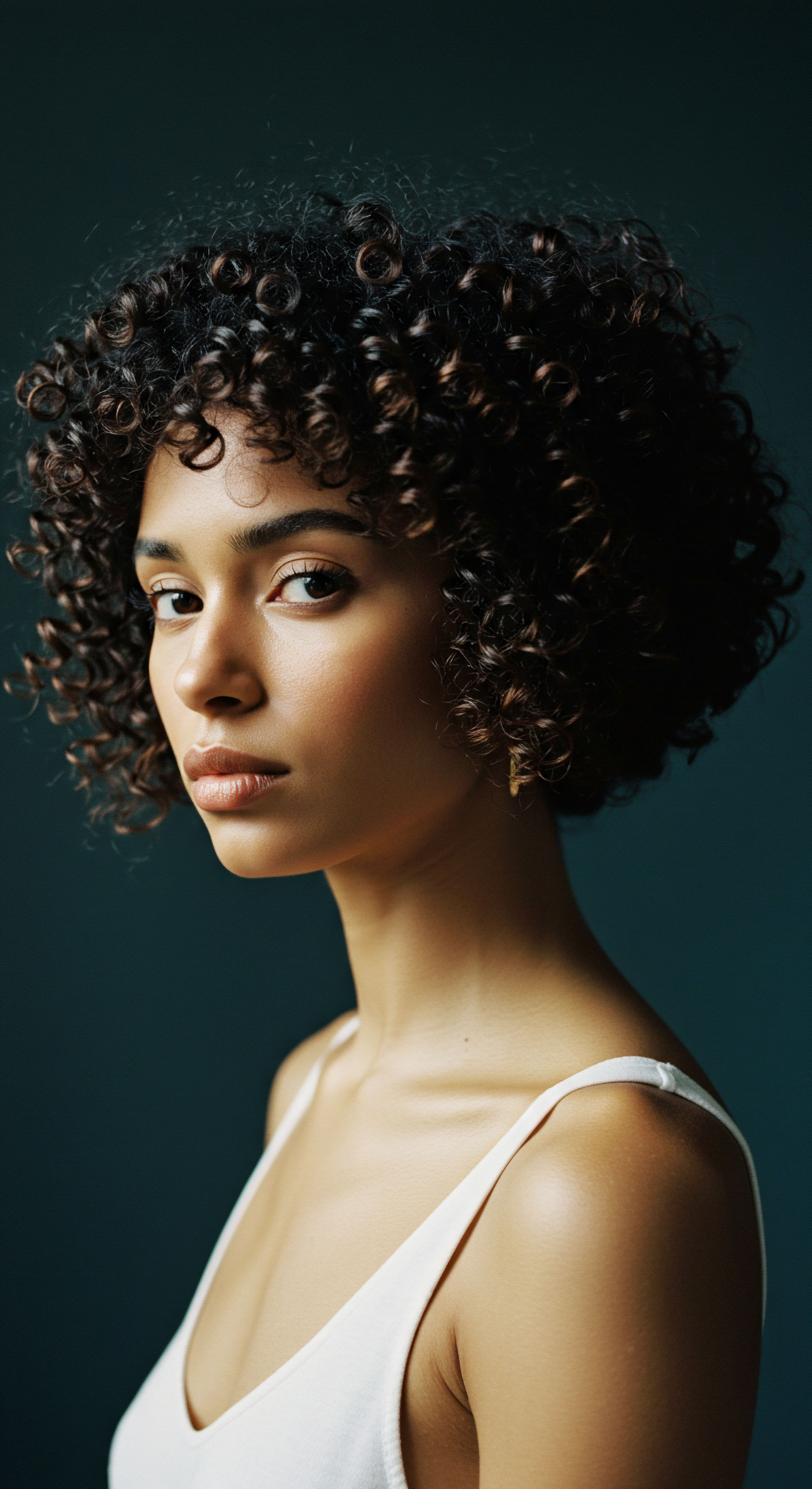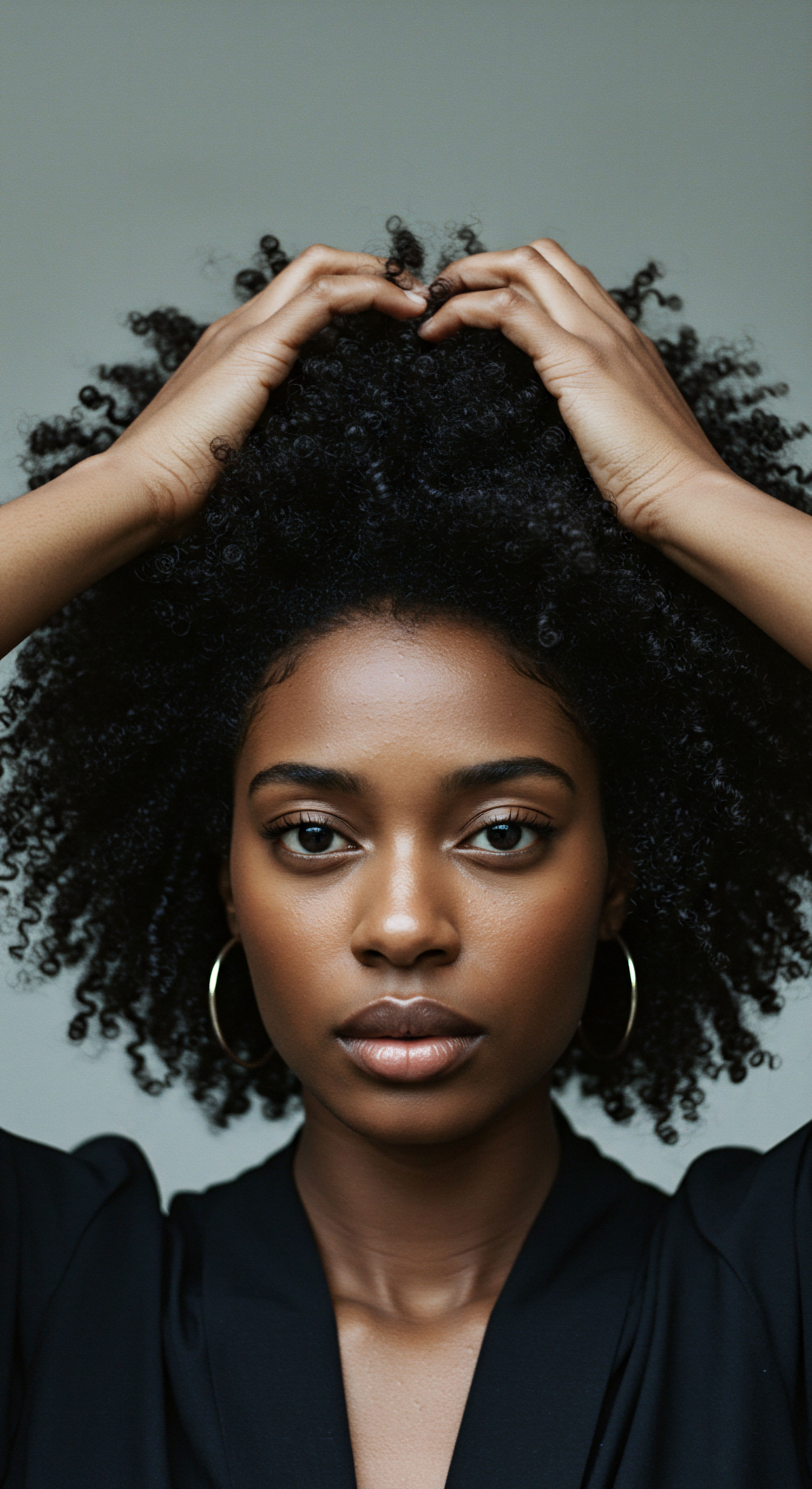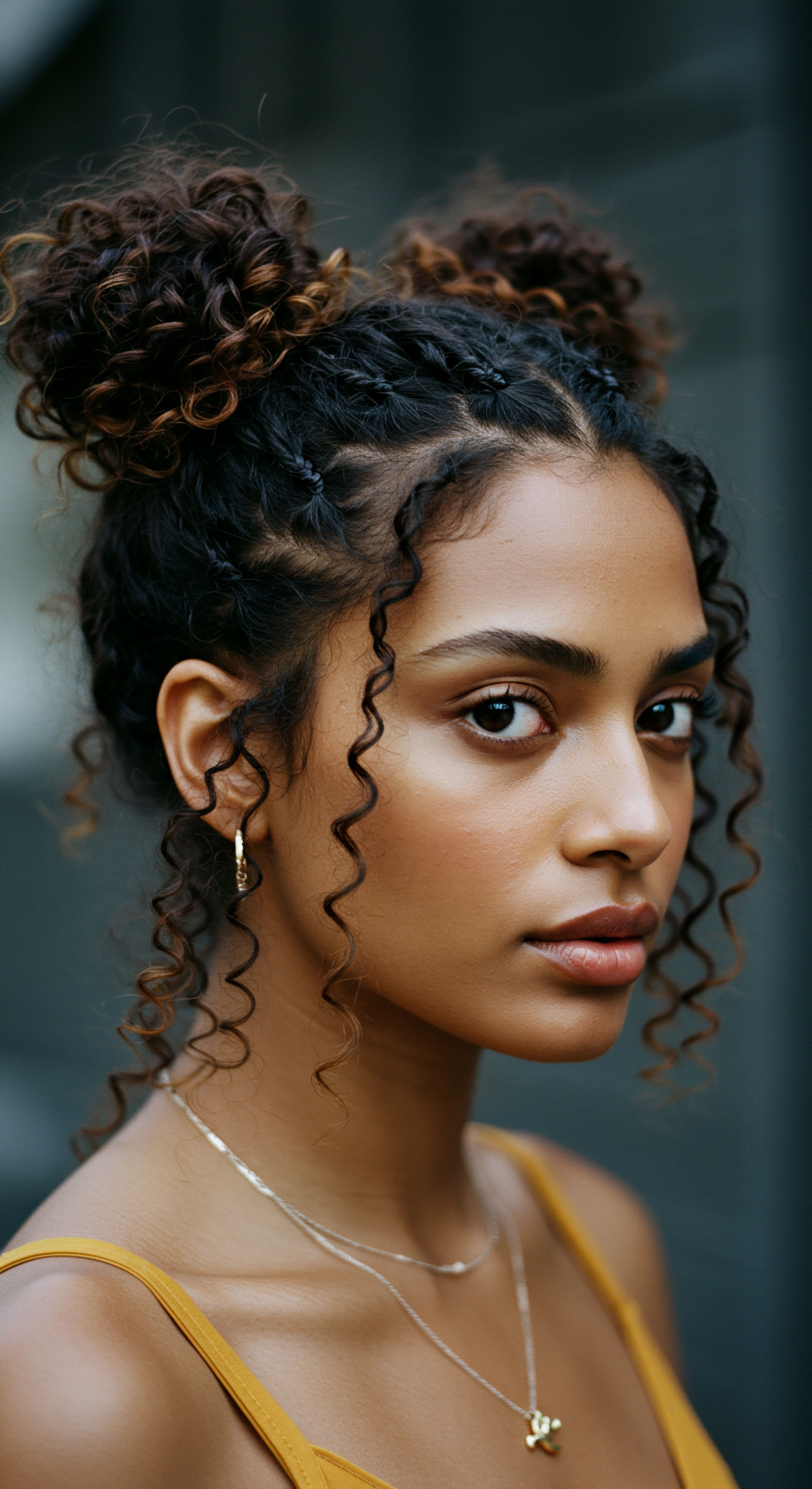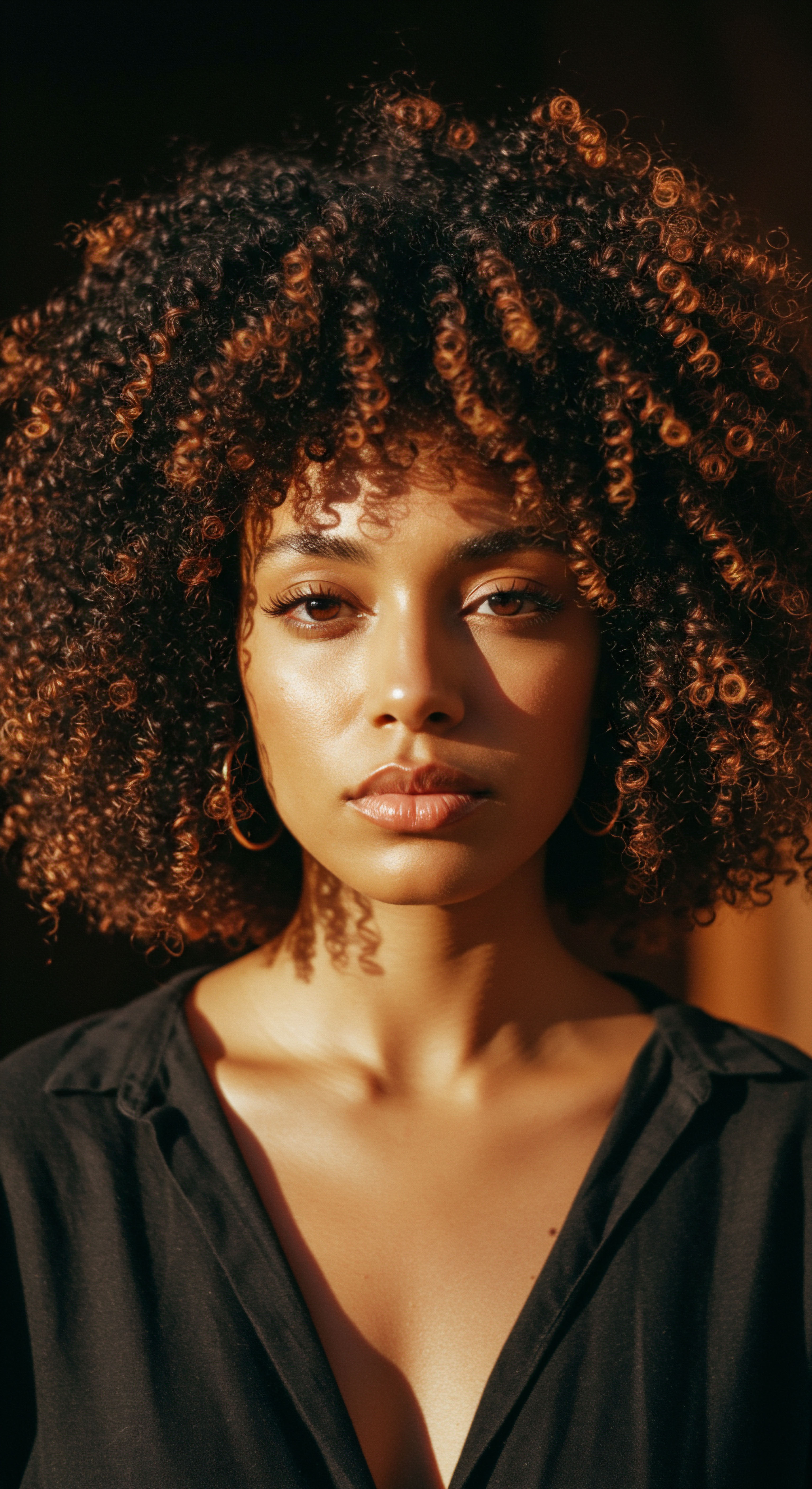
Roots
The whisper of the wind through ancient trees, the quiet strength of a mountain’s foundation—these natural elements hold a deep resonance for understanding our hair. Just as the earth’s composition shapes the growth of a mighty oak, the inherent nature of our hair’s outermost layer, its porosity, profoundly shapes how effectively moisture is welcomed and retained within each strand. For those with textured hair, this fundamental property holds particular significance, often dictating the daily dance of hydration and definition. We invite you to consider this elemental connection, moving beyond fleeting trends to truly see and honor the core of your hair’s being.

What is Hair Porosity’s Intrinsic Design?
At its very core, hair porosity describes the ability of a hair strand to absorb and hold onto moisture. This characteristic is primarily governed by the structure of the hair’s cuticle, the outermost protective layer of each strand. Imagine these cuticles as tiny, overlapping shingles on a roof. The way these shingles lie—whether tightly closed, slightly lifted, or widely spaced—determines how easily water and other nourishing substances can enter or leave the hair shaft.
This structural design is not merely a matter of chance; it is largely determined by genetics, passed down through generations. However, the story does not end there. While a person may be born with a certain inherent porosity, external influences can significantly alter this natural state over time.
Hair porosity, the hair’s capacity to absorb and hold moisture, is fundamentally shaped by the arrangement of its cuticle scales.
Factors such as heat styling, chemical processes like coloring or relaxing, and even environmental stressors such as prolonged sun exposure or pollution can cause the cuticles to lift, chip, or become damaged, thereby increasing porosity. This concept, sometimes termed “weathering,” describes the gradual breakdown of the hair’s outer layers from root to tip due to daily wear and tear.

How Do Hair Cuticles Influence Hydration?
The relationship between the hair cuticle and moisture is a dynamic one. The cuticle acts as a gatekeeper, controlling the flow of water and other beneficial elements into the inner cortex, which contains the fibrous proteins and pigment that give hair its color. When these cuticles are tightly sealed, as in low porosity hair, moisture struggles to enter the hair shaft.
This can lead to products sitting on the surface, making hair feel heavy or coated. Yet, once moisture does find its way in, low porosity hair is often quite adept at retaining it.
Conversely, with high porosity hair, the cuticles are more open, or even damaged, creating gaps and holes. While this allows moisture to be absorbed quickly, it also means that moisture escapes just as rapidly, leading to dryness, frizz, and a feeling of roughness. Medium porosity hair, often considered a harmonious balance, possesses cuticles that are neither too tight nor too open, allowing for efficient absorption and good retention of moisture. This type of hair typically responds well to a variety of care approaches and maintains a healthy appearance.
Understanding these foundational characteristics of hair porosity is not merely academic; it is the first step in cultivating a care routine that truly respects and responds to your hair’s unique requirements.

Ritual
Stepping into the realm of daily care, we encounter the rhythms and practices that shape our hair’s wellbeing. The conscious selection of products, the mindful application of treatments—these are the rituals that translate understanding into tangible nourishment. Here, we delve into how a recognition of your hair’s porosity can guide these practices, transforming a simple routine into a supportive dialogue with your strands. It is a journey of practical wisdom, where gentle guidance meets the unique needs of each hair type.

How Do Product Choices Respond to Porosity Levels?
The profound connection between hair porosity and moisture retention becomes especially clear when selecting hair care products. Each porosity type beckons for a particular approach, a tailored blend of ingredients and textures to achieve optimal hydration and health.
- Low Porosity Hair ❉ This hair type, with its tightly bound cuticles, can be resistant to moisture absorption. Products tend to sit on the surface, leading to buildup. For this reason, lightweight, water-based products are often recommended. Ingredients like Glycerin, Aloe Vera, and Honey act as humectants, drawing moisture from the environment without overburdening the hair. Light oils such as Argan Oil or Grapeseed Oil can seal moisture without creating a heavy residue.
- High Porosity Hair ❉ In contrast, hair with open cuticles readily absorbs moisture but struggles to hold onto it. This hair craves intense hydration and ingredients that help seal the cuticle. Richer, more hydrating formulations are often beneficial. Look for products containing ingredients like Shea Butter, Coconut Oil, Jojoba Oil, or Argan Oil, which can deeply moisturize and create a protective barrier. Protein treatments can also assist in filling gaps within the cuticle, temporarily strengthening the strand and making it less porous.
- Medium Porosity Hair ❉ Often described as the ideal balance, medium porosity hair absorbs and retains moisture effectively. The focus for this type of hair lies in maintaining its natural equilibrium. Products that offer a balance of hydration and protein are suitable. Leave-in conditioners and sealants can further assist in locking in moisture without causing heaviness.

Does Heat Aid Moisture Absorption for Certain Hair Types?
For individuals with low porosity hair, a unique challenge arises ❉ how to coax the tightly closed cuticles to open and welcome moisture. Here, the thoughtful application of heat can become a valuable ally in the care ritual.
Applying a deep conditioner with gentle heat, perhaps through a hooded dryer, a steam cap, or even a warm towel wrapped around conditioned hair, can assist in lifting the cuticles just enough to allow products to penetrate more effectively. This gentle warmth helps the hair absorb the nourishing ingredients, promoting deeper hydration and softness that might otherwise be difficult to achieve.
Tailoring hair care to porosity levels ensures products truly nourish, rather than merely sit upon, the hair.
Conversely, for high porosity hair, which already has open cuticles, excessive heat styling should be approached with caution. While some heat protection is always wise, the goal here is to minimize further damage and moisture loss, as high porosity hair is already susceptible to breakage and dryness. Prioritizing heat-free styles or using high-quality heat protectants is particularly important for this hair type.

What Role Does Sealing Play in Sustained Hydration?
Beyond the initial absorption, the true measure of moisture retention lies in how effectively that moisture is sealed within the hair shaft. This sealing step is a cornerstone of effective hair care, particularly for textured hair, which often has a natural tendency towards dryness.
For high porosity hair, sealing is paramount. After applying a water-based leave-in conditioner or moisturizer, following with a heavier oil or butter can create a protective barrier that helps to prevent the rapid escape of moisture. This method helps to “lock in” the hydration that has been absorbed. Common choices include Coconut Oil, Olive Oil, Jojoba Oil, Shea Butter, or Castor Oil.
For low porosity hair, while the cuticles are tight, a light oil or cream can still be beneficial to seal in the moisture that has successfully penetrated. The goal is to prevent the limited moisture from evaporating without adding excessive weight or causing product buildup. The Liquid, Oil, Cream (LOC) Method or Liquid, Cream, Oil (LCO) Method, which involves layering a liquid (water or leave-in), then an oil, then a cream, is a popular strategy for many with textured hair, adaptable to different porosity needs. The sequence can be adjusted based on how readily hair absorbs and retains moisture.
These deliberate steps, chosen with an understanding of your hair’s porosity, transform routine actions into purposeful acts of nourishment, fostering strands that feel soft, supple, and truly cared for.

Relay
Our journey into hair porosity now moves beyond the immediate and visible, reaching into the deeper currents of science, history, and cultural resonance. The very structure of our hair, its capacity to hold moisture, is not an isolated biological fact but a point where genetics, environment, and ancestral practices converge. Here, we seek a more profound insight, considering the interplay of these forces and how they inform our contemporary understanding of hair’s relationship with hydration.

What Does Advanced Science Reveal About Hair Hydration Beyond the Cuticle?
While the cuticle’s role in porosity is widely acknowledged, modern hair science points to more intricate mechanisms at play within the hair fiber itself. Research has revealed that the hair’s internal structure, particularly the cortex and the Cell Membrane Complex (CMC), also plays a significant role in moisture absorption and retention. The cortex, the thickest layer of the hair, swells as it absorbs water, and this swelling is not uniform. This internal hydration contributes to changes in hair’s mechanical properties, such as elasticity and strength.
A study by Breakspear et al. has brought to light previously unrecognized swelling behavior of the hair cuticle during moisture absorption, suggesting its heightened significance in moisture management, especially at higher relative humidity levels. This implies that the cuticle is not merely a passive barrier but an active participant in the hair’s hydration dynamics, responding to its environment in complex ways.
Furthermore, the presence of the F-Layer (18-MEA Layer), a thin, lipid-based coating on the outermost cuticle, renders virgin hair hydrophobic, influencing how water initially interacts with the strand. Damage to this layer, often from chemical or mechanical stressors, can render the hair more hydrophilic, making it behave like high porosity hair even if the underlying cuticle structure remains largely intact.
Consider the intriguing finding from TRI Princeton’s research, which suggests that for very coily hair, increased water content might actually be beneficial in preventing breakage, contrasting with the general understanding that overly hydrated hair can be more fragile. This challenges a long-held notion in hair science, highlighting the unique properties of textured hair and the need for specialized research. Single fiber tensile tests performed at TRI have shown that occlusive treatments applied to textured hair can maintain higher moisture levels and reduce premature fracturing when the hair is stretched. This specific data point underscores that the conventional wisdom regarding moisture and hair strength may not universally apply, particularly to the unique structural demands of coily textures.
| Component Cuticle |
| Primary Role in Moisture Outermost protective layer, controls entry and exit of moisture. |
| Impact on Porosity Its integrity (open/closed) directly defines porosity level. |
| Component Cortex |
| Primary Role in Moisture Innermost layer, absorbs water and swells, influencing hair's mechanical properties. |
| Impact on Porosity Internal hydration affects hair's overall suppleness and strength. |
| Component Cell Membrane Complex (CMC) |
| Primary Role in Moisture Connects cuticle cells and cortical cells, a pathway for water. |
| Impact on Porosity Its condition influences how water moves through the hair structure. |
| Component F-Layer (18-MEA) |
| Primary Role in Moisture Lipid coating on cuticle, makes virgin hair water-repelling. |
| Impact on Porosity Its presence or absence dictates initial water interaction. |
| Component A multi-layered system dictates hair's interaction with water. |

How Do Cultural Traditions Inform Hair Porosity Care?
The understanding of hair’s interaction with moisture is not solely a modern scientific pursuit; it is deeply interwoven with cultural practices that span centuries, particularly within communities with textured hair. Long before the term “porosity” entered popular lexicon, ancestral knowledge recognized the need for specific approaches to maintain hair health and moisture retention.
In many African communities, hair was and remains a profound symbol of identity, status, and spirituality. Hair care rituals were communal activities, passed down through generations, often utilizing natural ingredients readily available from the environment. Shea butter, coconut oil, aloe vera, and various herbs were not merely cosmetic choices; they were chosen for their observed effects on hair’s ability to retain moisture and resist environmental challenges. These traditions, predating modern scientific classification, inherently addressed the challenges of moisture retention in highly coiled hair, which naturally loses moisture quickly due to its structure.
The historical context of Black hair care in the diaspora further illuminates this connection. During periods of enslavement, traditional hair care practices were often suppressed, yet braiding persisted as an act of resistance and cultural preservation. Later, the natural hair movement, gaining prominence in the 1960s and experiencing a resurgence in the 2000s, brought renewed focus on understanding and celebrating African American hair in its natural state. This movement, driven by a desire for self-acceptance and cultural pride, implicitly recognized the unique moisture needs of textured hair, leading to a demand for products and practices that honored its inherent properties, rather than attempting to alter them through harsh chemical means.
The journey of hair porosity understanding transcends scientific labs, reaching into ancestral wisdom and cultural resilience.
Even today, methods like the LOC/LCO methods, while seemingly modern hair care techniques, echo the layered application of natural ingredients—liquids, oils, and creams—that have been used for centuries to seal moisture into hair. This historical continuity demonstrates a deeply intuitive, culturally informed understanding of hair’s moisture dynamics, long before scientific instruments could precisely measure cuticle integrity or water absorption rates.

Can Environmental Factors Alter Hair Porosity?
Beyond genetics and intentional treatments, the very air we breathe and the sun that shines upon us exert a subtle, yet persistent, influence on hair porosity. Environmental factors are not mere background noise; they are active agents in shaping the hair’s outer structure and its capacity for moisture retention.
Exposure to intense sunlight, particularly UV-B rays, can degrade the protective cuticle layer and penetrate the hair shaft, breaking down essential proteins and accelerating porosity. This UV damage can strip hair of its natural moisture, rendering it more susceptible to dryness, breakage, and frizz. Similarly, pollution from vehicles, industrial emissions, and even indoor chemicals can deposit a layer of grime on strands, potentially dulling hair and contributing to damage.
Changes in humidity also play a significant role, particularly for hair with varying porosity levels. In highly humid environments, high porosity hair can absorb excess moisture from the air, sometimes leading to frizz and a “puffy” appearance. Conversely, in dry environments, humectants, which are designed to attract and retain moisture, can paradoxically draw water from the hair itself if the air lacks sufficient humidity, making low porosity hair even drier. This highlights the need for dynamic hair care, adapting routines not only to inherent porosity but also to the prevailing environmental conditions.
These external pressures underscore that hair porosity is not a static characteristic but a dynamic state, constantly interacting with its surroundings. A truly supportive hair care philosophy acknowledges these influences, prompting us to adjust our methods and product choices to protect our strands from the relentless demands of the world around us.

Reflection
As we step back from the intricate world of hair porosity, a deeper appreciation settles upon us for the remarkable complexity of our strands. The question of whether hair porosity impacts moisture retention reveals itself not as a simple yes or no, but as an invitation into a multi-layered conversation. It speaks to the whispers of our genetic inheritance, the stories etched into our cultural traditions, and the ever-present dialogue between our hair and the world it inhabits.
To truly care for our hair is to listen to these whispers, to honor its unique architecture, and to respond with a gentle, knowing touch. It is a journey of continuous discovery, where every strand holds a universe of wisdom, waiting to be understood and celebrated.

References
- HairKnowHow.Com. High Porosity Hair ❉ What It Means For Your Hair.
- NYSCC. An Overview on Hair Porosity.
- Carol’s Daughter. What You Need to Know About Hair Porosity.
- Hair Free Hair Grow. Understanding High Porosity Hair and its Impact on Hair Care.
- Historical Perspectives on Hair Care and Common Styling Practices in Black Women.
- Halo Haircare Society. The Truth about Hair Porosity.
- Hair Porosity Unveiled ❉ Your Guide to Understanding and Caring for Your Hair Type.
- The Link Between Hair Porosity and Effective Hair Care with Viori.
- WebMD. What to Know About Low Porosity Hair.
- Red Carpet Curls. The Science Behind Porosity & Naturally Textured Hair.
- Glow by Daye. Tips to Maintain Hair Moisture in the Summer Based on Your Porosity.
- Curlsmith. Everything you Need to Know about Medium Porosity Hair.
- OrganiGrowHairCo. Humectants and Hair Porosity ❉ Understanding Their Effects.
- EBSCO Research Starters. Afro-textured hair.
- Healthline. What Type of Hair Porosity Do You Have?
- KeraVada. Unraveling the Mystery of Hair Porosity (Low and High) ❉ A Deep Dive fo.
- Medium Porosity Hair ❉ Care Tips, Best Products & Styling.
- Pilgrim India. How to Care for Low Porosity Hair ❉ 10 Expert Tips.
- Yuaia Haircare. Hair porosity ❉ How it affects your hair products.
- HairKnowHow.Com. Hair Clinic Porosity Test For Hair Clinics, Trichologists, And Clients.
- MDPI. The Genomic Variation in Textured Hair ❉ Implications in Developing a Holistic Hair Care Routine.
- Theradome. What is Medium Porosity Hair? How to Identify & Care?
- DOC Japan株式会社. Understanding Hair Porosity ❉ Causes and Solutions.
- Noma Sana. Understanding Hair Porosity ❉ What It Means for Your Textured Hair.
- Absolutely Everything Curly. Hair Texture, Porosity, Density | Hair Biology 101.
- WholEmollient. Hair Porosity Test at Home | Textured Hair Mapping Guide.
- St.Botanica. Understanding Low Porosity Hair ❉ Best Tips for Care.
- Tangle Teezer. 5 Tips for Managing High-Porosity Hair with Tangle Teezer.
- Brown Butter Beauty. Hair Care Tips for Type 4 High Porosity Hair.
- J-Stage. Recent Progress in Hair Science and Trichology.
- St.Botanica. Low Porosity Hair Care ❉ Essential Tips for Healthier Strands.
- TRI Princeton. Hair Moisturization Claims 101.
- Hair Care Practices from the Diaspora ❉ A Look at Africa, America, and Europe.
- HOW TO DETERMINE HAIR POROSITY AND WHAT IT MEANS FOR YOUR HAIR.
- K18 Hair. The science of hair drying.
- PubMed. Cuticle – Designed by nature for the sake of the hair.
- Wimpole Clinic. High Porosity Hair ❉ The Definitive Guide For Porous Hair.
- The Resilient Tresses ❉ West African Black Hair History from the 1400s to Today #63.
- Wikipedia. Natural hair movement.
- PMC. Hair Cosmetics ❉ An Overview.
- ResearchGate. Moisture in the Cuticle Sheath ❉ Effects on Hair Mechanical and Cosmetic Properties.